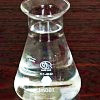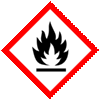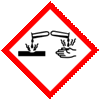Ethyl Trifluoroacetate Manufacturers, with SDS GHS MSDS Sheet |
Supplier, Manufacturer, Exporter of Ethyl Trifluoroacetate, Muby Chemicals of Mubychem Group, established in 1976, is the original manufacturers of Specialty Chemicals, Pharmaceutical Excipient, Fragrance Food & Flavor chemicals, Reagent Grade Chemicals, Shale Gas Fracturing Chemicals in India. Mubychem Group has several manufacturing facilities spread across Western India and world wide contacts and toll manufacturers. We are exporting globally to countries like USA, Canada, Europe, UAE, South Africa, Tanzania, Kenya, Egypt, Nigeria, Cameroon, Uganda, Turkey, Mexico, Brazil, Chile, Argentina, Dubai, Korea, Vietnam, Thailand, Malaysia, Indonesia, Australia, China, Germany, France, Italy Portugal, Bangladesh, etc. The products are offered as per required specifications and in correct shape and size in mm or meshs or microns as specified by the buyer. The participating units have one or more accreditations like FDA - cGMP and GLP approval, ISO-9001 Certified, "REACH" Registered, ISO-14001, ISO/IEC 17025, ISO-22000, FSSC 22000, ISO 45001, Kosher Certified, Halal Certified, HACCP, FSSAI. We offer Commercial Pure & IP BP EP Ph Eur USP NF JP FCC Food Grade Analytical Reagent Grades of Chemicals |
| Bookmark this Web Site -- or -- Email This Page Info to a Colleague or Yourself |
Search our website here:







Ethyl Trifluoroacetate: CAS Number: 383-63-1, EINECS EC Number: 206-851-6, Molecular Formula: C4H5F3O2 or CF3COOC2H5, Molecular Weight: 142.08, HS Code ---**
How big is your requirement or how small
We serve it all.
Specifications, Safety Data Sheet, Manufacturing process details, Wholesale retail buy sell prices, Uses etc available on line in these pages for Ethyl Trifluoroacetate.
For SDS MSDS Sheet Click
SDS MSDS Sheet of Ethyl Trifluoroacetate Manufacturers
Ethyl Trifluoroacetate
Pure Suppliers

Properties and Specifications of Ethyl Trifluoroacetate:
Appearance: Colorless liquid.
Assay: 99% minimum.
Melting point: -78C literature.
Boiling point: 60C to 62C literature.
Flash point: -1C.
Relative density: 1.190 to 1.195 literature.
We manufacture and supply as under:
2,5-Bis-(2,2,2-Trifluoroethoxy) Benzoic Acid
6-Fluoro-3,4-dihydro-2H-1-benzopyran-2-carboxylic acid
Manufacturers:
MUBY CHEMICALS
Ambernath Mumbai, Ankleshwar Gujarat, India
TEL: (OFFICE) +912223770100, +912223726950
Current Date Time in India GMT+5:30
e-mail: info@mubychem.com
USA, Canada, Mexico and other American neighbouring buyers may
e-mail: us@mubychem.com
Call toll-free 1-877-682-9243 (1-877-MUBYCHEM)

Copyright and Usual Disclaimer is Applicable.
Last 30 November, 2025




Exporters to USA Canada UAE Europe South Africa Tanzania Kenya Uganda Egypt Nigeria Turkey Mexico Brazil Argentina Chile Dubai etc.
Global or International Suppliers, Exporters, Importers, Manufacturers
I shall pass through this world, but once. If therefore, there is any good that I can do, or if there is any favor that I can show to a fellow human being, let me do it now. Let me not defer or neglect it. For I shall not tread this way again
Ethyl Trifluoroacetate SDS, Safety Data Sheet
MSDS Sheet, Material Safety Data Sheet 19-Oct-20
Section 1 - Chemical Product and Company Identification
Product Name & Other Names: Ethyl Trifluoroacetate.
CAS#: 383-63-1
EINECS EC Number: 206-851-6
Molecular Formula: C4H5F3O2 or CF3COOC2H5
Molecular Weight: 142.08
Relevant uses and uses advised against (if any): Industrial Manufacturing.
Suppliers: As per letterhead.
Section 2 - Hazards Identification
GHS, Globally Harmonized System Classification in accordance with 29 CFR 1910
Classification according to Regulation (EC) No 1272/2008
Flammable liquids Category 2, H225
Skin corrosion Category 1B, H314
Specific target organ toxicity - single exposure Category 3, Respiratory system, H335
Labeling according to GHS & Regulation (EC) No 1272/2008
GHS Label Elements  Combustible Liquid |
GHS Label Elements  Corrosive |
Signal Words: Danger
Hazard statements:
H225: Highly flammable liquid and vapor.
H314: Causes severe skin burns and eye damage.
H335: May cause respiratory irritation.
Precautionary statements:
P210: Keep away from heat, sparks, open flames, hot surfaces. - No smoking.
P233: Keep container tightly closed.
P240: Ground/bond container and receiving equipment.
P241: Use explosion-proof electrical, ventilating, lighting equipment.
P242: Use only non-sparking tools.
P243: Take precautionary measures against static discharge.
P260: Do not breathe mist, vapors, spray.
P264: Wash exposed skin thoroughly after handling.
P280: Wear protective clothing, protective gloves, eye protection, face protection.
P301+P330+P331: IF SWALLOWED: rinse mouth. Do NOT induce vomiting.
P303+P361+P353: IF ON SKIN (or hair): Remove/Take off immediately all contaminated clothing. Rinse skin with water/shower.
P304+P340: IF INHALED: remove victim to fresh air and keep at rest in a position comfortable for breathing.
P305+P351+P338: If in eyes: Rinse cautiously with water for several minutes. Remove contact lenses, if present and easy to do. Continue rinsing.
P310: Immediately call a POISON CENTER or doctor/physician.
P314: Get Medical advice/attention if you feel unwell.
P337+P313: If eye irritation persists: Get medical advice/ attention.
P360: Rinse immediately contaminated clothing and skin with plenty of water before removing clothes.
P363: Wash contaminated clothing before reuse.
P370+P378: In case of fire: Use carbon dioxide (CO2), powder, alcohol-resistant foam for extinction.
P403+P235: Store in a well-ventilated place. Keep cool.
P405: Store locked up.
P501: Dispose of contents/container to comply with local, state and federal regulations.
Classification according to EU Directives 67/548/EEC or 1999/45/EC:
Hazard Symbols:
F Flammable
C Corrosive
Risk Phrases:
R11 Highly flammable.
R34 Causes burns.
R37 Irritating to respiratory system.
R41 Risk of serious damage to eyes
Section 3 - Composition/Information on Ingredients
Product Name & Other Names: Ethyl Trifluoroacetate.
CAS#: 383-63-1
EINECS EC Number: 206-851-6
Section 4 - First Aid Measures
Always consult a physician after the first aid is given.
Eyes: Immediately flush eyes with plenty of water for at least 15 minutes, occasionally lifting the upper and lower eyelids. Get medical aid. Do NOT allow victim to rub or keep eyes closed.
Skin: Flush skin with plenty of soap and water for at least 15 minutes while removing contaminated clothing and shoes. Get medical aid if irritation develops or persists. Wash clothing before reuse.
Ingestion: Do NOT induce vomiting. If victim is conscious and alert, give 2-4 cup-full of milk or water. Never give anything by mouth to an unconscious person. Get medical aid.
Inhalation: Remove from exposure to fresh air immediately. If breathing is difficult, give oxygen. Get medical aid. Do NOT use mouth-to-mouth resuscitation. If breathing has ceased apply artificial respiration using oxygen and a suitable mechanical device such as a bag and a mask.
Notes to Physician: Treat symptomatically and supportively.
Section 5 - Fire Fighting Measures
General Information: As in any fire, wear a self-contained breathing apparatus in pressure-demand, MSHA/NIOSH (approved or equivalent), and full protective gear. During a fire, irritating and highly toxic gases may be generated by thermal decomposition or combustion.
Flash Point: -1C.
Special hazards arising from the substance or mixture: Carbon oxides, Hydrogen fluoride, fumes. Flash back possible over considerable distance.
Extinguishing Media: Do NOT use solid water jet or foam. Use CO2, dry chemical, dry sand. Water mist may be used to cool closed containers to prevent pressure build-up, auto-ignition or explosion. EMITS TOXIC FUMES UNDER FIRE CONDITIONS.
Special Information: In the event of a fire, wear full protective clothing and NIOSH-approved self-contained breathing apparatus with full face piece operated in the pressure demand or other positive pressure mode. At high temperatures under fire conditions, it may produce toxic or irritating fumes.
Section 6 - Accidental Release Measures
Personal precautions, protective equipment and emergency procedures: Avoid breathing dust/fumes/gas/mist/vapors/spray. Ensure adequate ventilation. Use individual protective equipment (waterproof boots, suitable protective clothing, safety glasses, etc.). Restrict unprotected personnel from the area. Prevent any contact with hot surfaces. Do not approach facing the wind. Do not touch the spilled material.
Environmental precautions: Do not let the product enter drains, soil or water sources.
Methods and materials used for containment Cleanup procedures and Storage: Contain spilled material. Use proper personal protective equipment. Restrict unprotected personnel from the area. Remove all ignition sources and ventilate area. Contain the spill with sand or other inert absorbent material and deposit in a sealed bag or container. Use water spray to dilute spill to a non-flammable mixture. Avoid runoff into storm sewers and ditches which lead to waterways. Wash area with soap and water. Use water spray to disperse the gas/vapor. Remove all sources of ignition. Use a spark-proof tool. Provide ventilation.
Section 7 - Handling and Storage
Precautions for safe handling: Apply according to good manufacturing and industrial hygiene practices. Ensure proper ventilation. Wash thoroughly after handling. Do not drink, eat or smoke while handling. Avoid contact with skin, eyes and clothing. Minimize dust generation. Avoid breathing dust/fumes/gas/mist/vapors/spray. Avoid contact with eyes, skin, and clothing. Keep container tightly closed. Avoid ingestion and inhalation. Use individual protective equipment (waterproof boots, suitable protective clothing, safety glasses, etc.). Prevent any contact with hot surfaces.
Conditions for safe storage, including any incompatibilities: Store in cool, dry and ventilated area away from heat sources and protected from sunlight in tightly closed original container. Keep air contact to a minimum. Do not leave the material container open. Store protected from heat, sparks and ignition sources and incompatible materials. Avoid contact with skin and eyes. Avoid inhalation of dust/mist/vapor. Do not store with incompatible materials like strong oxidizing agents, strong acids, strong bases, strong reducing agents.
Section 8 - Exposure Controls, Personal Protection
Airborne Exposure Limits: Airborne Exposure Limits: This product does not contain any hazardous materials with occupational exposure limits established by the region specific regulatory bodies.
Ventilation System: A system of local and/or general exhaust is recommended to keep employee exposures as low as possible. Local exhaust ventilation is generally preferred because it can control the emissions of the contaminant at its source, preventing dispersion of it into the general work area. Please refer to the ACGIH document, Industrial Ventilation, A Manual of Recommended Practices, most recent edition, for details.
Personal Respirators (NIOSH Approved): For conditions of use where exposure to dust or mist is apparent and engineering controls are not feasible, a particulate respirator (NIOSH type N95 or better filters) may be worn. If oil particles (e.g. lubricants, cutting fluids, glycerin, etc.) are present, use a NIOSH type R or P filter. For emergencies or instances where the exposure levels are not known, use a full-face positive-pressure, air-supplied respirator. WARNING: Air-purifying respirators do not protect workers in oxygen-deficient atmospheres.
Skin Protection: Wear impervious protective clothing, including boots, gloves, lab coat, apron or coveralls, as appropriate, to prevent skin contact.
Eye Protection: Use chemical safety goggles and/or full face shield where dusting or splashing of solutions is possible. Maintain eye wash fountain and quick-drench facilities in work area of Propionic acid.
Other Control Measures: Maintain good housekeeping in work area. Dust deposits on floors and other surfaces may pick up moisture and cause the surfaces to become slippery and present safety hazards. Handle in accordance with good industrial hygiene and safety practice. Wash hands after handling.
Section 9 - Physical and Chemical Properties
Appearance: Colorless liquid.
Odor: Not available.
Odor threshold: Not available.
pH: Not available.
Relative density: 1.190 to 1.195 literature.
Boiling Point: 60C to 62C literature.
Melting Point: -78C literature.
Flash Point: -1C.
Auto Ignition Temperature: Not available.
Decomposition temperature: Not available.
Upper/lower flammability or explosive limits: Not available.
Vapor pressure: Not available.
Vapor density: Not available.
Evaporation rate: Not available.
Flammability (solid, gas): Not available.
Partition coefficient: n-octanol/water: Not available.
Solubility: Not available.
Viscosity: Not available.
Molecular Formula: C4H5F3O2 or CF3COOC2H5
Molecular Weight: 142.08
Section 10 - Stability and Reactivity
Chemical Stability: Propionic acid is stable under normal temperatures and pressures.
Conditions to Avoid: Incompatible materials, exposure to heat, flames, sparks. moisture.
Incompatibilities with Other Materials: Strong oxidizing agents, strong acids, strong bases, strong reducing agents.
Hazardous Decomposition Products: Carbon oxides, hydrogen fluoride, fumes.
Hazardous Polymerization: Will not occur.
Section 11 - Toxicological Information
Toxicity to animals: LD50 Oral >5 g/kg (Rat).
Carcinogenic Effects: Not a reported carcinogen by IARC, NTP, ACGIH, OSHA.
Mutagenic Effects: Not available.
Developmental Toxicity: Not available.
Reproductive Effects: No information available.
Section 12 - Ecological Information
Toxicity to fish: LC50 - Pimephales promelas (fathead minnow) - 6.000 mg/l - 96 h.
Environmental Fate: The material will readily biodegrade.
Persistence and Degradability: Soluble in water Persistence is unlikely.
Bioaccumulation/ Accumulation: No information available.
Mobility: Will likely be mobile in the environment due to its water solubility.
Results of PBT and vPvB assessment: Not available.
Section 13 - Disposal Considerations
Whatever cannot be saved for recovery or recycling should be managed in an appropriate and approved waste disposal facility. Processing use or contamination of this product may change the waste management options. State and local disposal regulations may differ from federal disposal regulations. Dispose of container of Propionic acid and unused contents in accordance with local requirements.
Section 14 - Transport Information
DOT USA and ADR/RID Europe
UN number: 1993
Proper Shipping Name: Flammable liquid, n.o.s. (Ethyl trifluoroacetate)
Class: 3; Packing group: II
IMDG
UN number: 1993
Proper Shipping Name: Flammable liquid, n.o.s. (Ethyl trifluoroacetate)
Class: 3; Packing group: II
IATA
UN number: 1993
Proper Shipping Name: Flammable liquid, n.o.s. (Ethyl trifluoroacetate)
Class: 3; Packing group: II
Section 15 - Regulatory Information
USA:
Section 313: No chemicals are reportable under Section 313.
SARA 311/312 Hazards: Acute Health Hazard, Fire Hazard. See section 2.
California Proposition 65: This product does not contain any Proposition 65 chemicals.
Section 16 - Additional Information
European Labeling in Accordance with EC Directives:
H225: Highly flammable liquid and vapor.
H314: Causes severe skin burns and eye damage.
H335: May cause respiratory irritation.
Classification according to EU Directives 67/548/EEC or 1999/45/EC:
Hazard Symbols:
F Flammable
C Corrosive
Risk Phrases:
R11 Highly flammable.
R34 Causes burns.
R37 Irritating to respiratory system.
R41 Risk of serious damage to eyes.
Disclaimer:
**************************
Our company provides this MSDS sheet in good faith but makes no representation as to its comprehensiveness or accuracy. This SDS sheet is intended only as a guide to the appropriate precautionary handling of the material by a properly trained person using this product. The above information has been compiled from various sources and has the possibility of discrepancy and being out-dated information. Individuals receiving the information must exercise their independent judgment and do further search in determining its appropriateness for a particular purpose. In no case shall our company be liable to loss or damages by the product user.
**************************
















